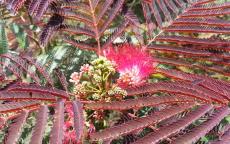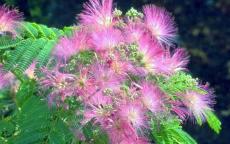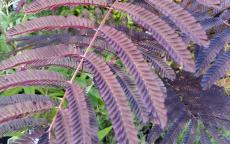Albizia (Silk) trees
Albizias or Silk trees are attractive small trees with feathery foliage and fluffy flowers, they do best in a sunny position.
Chocolate FountainTM
A purple-leaved weeping form of the Silk Tree, with the characteristic candy-floss pink flowers.£94.00buy- Flowering month: July
- Flowering month: August
- Flower colour: Pink
- Leaf colour: Bronze
Albizia julibrissinEvy's Pride
A form of the Persian silk tree with large pink flowers and fern-like leaves which turn brick red in the autumn.- Flowering month: July
- Flowering month: August
- Flower colour: Pink
- Leaf colour: Dark purple
Albizia julibrissinShidare
A very attractive spreading weeping Albizia, with feathery green foliage and pink summer flowers.- Flowering month: July
- Flowering month: August
- Flower colour: Pink
- Leaf colour: Green
Albizia julibrissinSummer Chocolate
A popular form of the Silk Tree with burgundy foliage and scented cream powder puff blooms.£94.00buy- Flowering month: July
- Flowering month: August
- Flower colour: Pink
- Leaf colour: Bronze
- Awards: RHS AGM (current)
Albizia julibrissin
How to choose Albizia (Silk) trees
Albizias, often known as Silk Trees, originated in central and eastern Asia, and are part of the Mimosa family. They are widely grown in gardens in France, Spain, and Italy - and if you have a shelted spot an Albizia will bring the exotic colours of southern Europe to the British garden.
They feature feathery fern-like leaves, which may be green or bronze, often taking on attractive autumn colours.
The flowers are produced over the summer, usually feathered or fluffy, and very pretty.
Albizias are generally slow-growing trees, eventually reaching a height of 3m-4m and a similar spread.
Many Albizias are able to fix nitrogen into the soil, and can be grown on relatively poor soils as long as they are free-draining. Many are drought-tolerant too, once fully established.
Most Albizias are only moderately hardy in the UK - they can generally tolerate temperatures down to about -5C. For this reason they should always be planted in a sheltered spot in full sun. A deep mulch of about 1m diameter around the base of the tree in the autumn will help insulate the roots. If you expect a very hard frost then try to wrap the tree with a horticultural fleece. Damage to exposed shoots is not uncommon in a cold winter, but can easily be remedied by just pruning back to the next bud.
In warm climates, particularly the southern USA, Albizias have a reputation for being invasive, mainly because they produce a lot of seeds which disperse over long distances. This is not an issue in the cool damp climate of the UK.
Their dramatic appearance makes them useful as feature trees, and they are also very suitable for training as informal fans across a south-facing wall. This is often a good way to grow an Albizia in the UK, because it makes it easy to protect the tree from winter cold by draping a horticultural fleece down over it.



